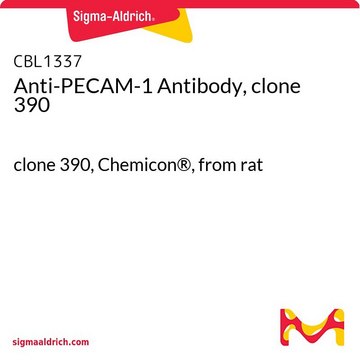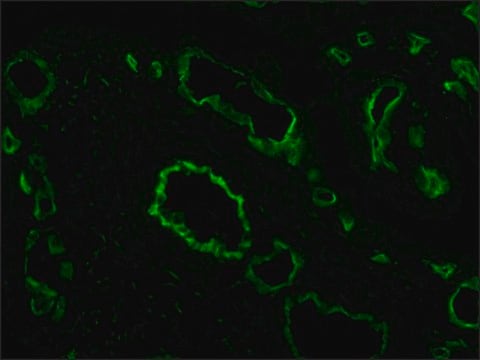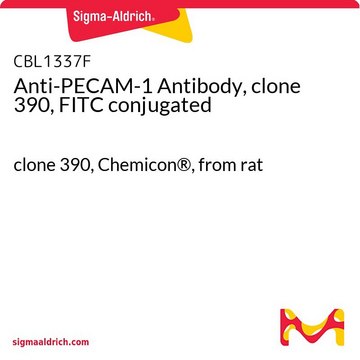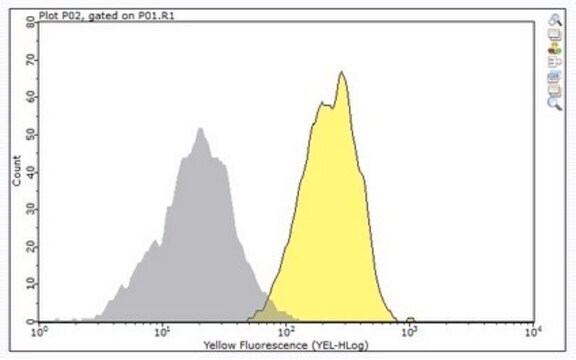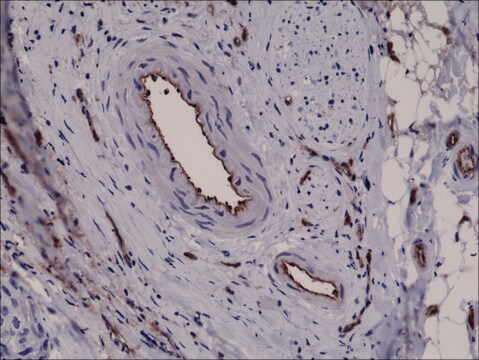CBL1337-I
Anti-PECAM-1 Antibody, clone 390
clone 390, from rat
Sinónimos:
Platelet endothelial cell adhesion molecule, CD31, PECAM-1
About This Item
Productos recomendados
origen biológico
rat
Nivel de calidad
forma del anticuerpo
purified immunoglobulin
tipo de anticuerpo
primary antibodies
clon
390, monoclonal
reactividad de especies
mouse
técnicas
flow cytometry: suitable
immunofluorescence: suitable
immunoprecipitation (IP): suitable
neutralization: suitable
isotipo
IgG2aκ
Nº de acceso NCBI
Nº de acceso UniProt
Condiciones de envío
ambient
modificación del objetivo postraduccional
unmodified
Información sobre el gen
mouse ... Pecam1(18613)
Categorías relacionadas
Descripción general
Especificidad
Inmunógeno
Aplicación
Immunofluorescence Analysis: A representative lot localized PECAM-1 immunoreactivity by fluorescent immunohistochemistry staining of murine embryo cryosections (Baldwin, H.S., et al. (1994). Development. 120(9):2539-2553).
Immunoprecipitation Analysis: A representative lot immunoprecipitated the 120-130 kDa exogenously expressed PECAM-1 ∆12,15 construct from transfected murine L-cells (Baldwin, H.S., et al. (1994). Development. 120(9):2539-2553).
Neutralizing Analysis: A representative lot inhibited the aggregation of murine L-cell transfectants expressing wild-type and ∆12,15, but not ∆14,15, murine PECAM-1 constructs (Baldwin, H.S., et al. (1994). Development. 120(9):2539-2553).
Clone 390 is also available as FITC conjugate (Cat. No. CBL1337F) for direct immunofluorescent staining in flow cytometry, immunocytochemistry and immunohistochemistry applications.
Cell Structure
Calidad
Flow Cytometry Analysis: 2 µL of this antibody detected PECAM-1-positive monocytes among one million mouse splenocytes.
Descripción de destino
Ligadura / enlace
Forma física
Almacenamiento y estabilidad
Handling Recommendations: Upon receipt and prior to removing the cap, centrifuge the vial and gently mix the solution. Aliquot into microcentrifuge tubes and store at -20°C. Avoid repeated freeze/thaw cycles, which may damage IgG and affect product performance.
Otras notas
Cláusula de descargo de responsabilidad
¿No encuentra el producto adecuado?
Pruebe nuestro Herramienta de selección de productos.
Código de clase de almacenamiento
12 - Non Combustible Liquids
Clase de riesgo para el agua (WGK)
WGK 2
Punto de inflamabilidad (°F)
Not applicable
Punto de inflamabilidad (°C)
Not applicable
Certificados de análisis (COA)
Busque Certificados de análisis (COA) introduciendo el número de lote del producto. Los números de lote se encuentran en la etiqueta del producto después de las palabras «Lot» o «Batch»
¿Ya tiene este producto?
Encuentre la documentación para los productos que ha comprado recientemente en la Biblioteca de documentos.
Nuestro equipo de científicos tiene experiencia en todas las áreas de investigación: Ciencias de la vida, Ciencia de los materiales, Síntesis química, Cromatografía, Analítica y muchas otras.
Póngase en contacto con el Servicio técnico